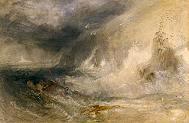Students will observe a watercolor painting that depicts a view of a landmark in a dramatic setting—Longships Lighthouse, Land's End by artist Joseph Mallord William Turner. Then they will experiment with a variety of techniques to create a dramatic setting, such as the scene depicted in Turner's historical narrative watercolor painting. Students will then create their own watercolor of an accident at a landmark using various watercolor techniques. |
 |
 |
 |
1. Show students the reproduction of Longships Lighthouse, Land's End by Joseph Mallord William Turner.
2. Have a class discussion, prompting students with the questions from the Background Information and Questions for Teaching about Longships Lighthouse, Land's End. Inform students that Turner depicted a story set in the ocean off the coast of England at Land's End, Cornwall, an area guarded by Longships Lighthouse. Ask students to point out the lighthouse and describe how it is used in the painting. (Nature seems to be overpowering the man-made landmark.)
3. Tell students that for their activity, they will create a watercolor of an accident that occurred at a landmark, as Turner did in his Longships Lighthouse, Land's End. Students will experiment with a variety of techniques to create a dramatic, abstract setting. Tell them they may consider painting the landmark against fog, smog, fire, or storm. Tell students they will select colors and brushwork that contribute to the feeling, point of view, and mood of the scene.
4. Either provide photos or images of important landmarks in your city, or instruct students to take a photo of a landmark in their neighborhood.
5. Pass out "Watercolor Techniques: Depicting a Landmark" and "Common Watercolor Techniques."
6. Provide students with all the supplies on the Materials list that they will need to complete the activity.
7. Guide students to follow the instructions on "Watercolor Techniques: Depicting a Landmark" to plan and then create their watercolor paintings. Tell students to refer to the handout "Common Watercolor Techniques" for tips on using techniques, such as scraping, scumbling, layering, blotting, and wet on wet, as they create their watercolor.
|
 |
 |
 |
| Longships Lighthouse, Land's End, Joseph Mallord William Turner, about 1834–1835
|
 |
|
 |
Common Core Standards for English Language Arts
Grades 9–12
READING
Key Ideas and Details
1. Read closely to determine what the text says explicitly and to make logical inferences from it; cite specific textual evidence when writing or speaking to support conclusions drawn from the text.
Integration of Knowledge and Ideas
7. Integrate and evaluate content presented in diverse media and formats, including visually and quantitatively, as well as in words.
SPEAKING AND LISTENING
Comprehension and Collaboration
1. Prepare for and participate effectively in a range of conversations and collaborations with diverse partners, building on others' ideas and expressing their own clearly and persuasively.
2. Integrate and evaluate information presented in diverse media and formats, including visually, quantitatively, and orally.
|
 |

|
 |




